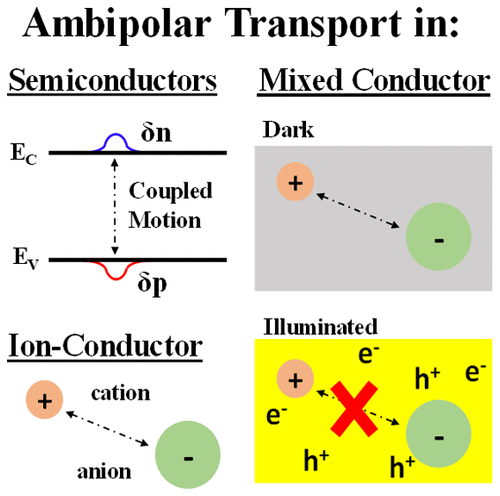当前位置:
X-MOL 学术
›
J. Phys. Chem. Lett.
›
论文详情
Our official English website, www.x-mol.net, welcomes your
feedback! (Note: you will need to create a separate account there.)
Ionic–Electronic Ambipolar Transport in Metal Halide Perovskites: Can Electronic Conductivity Limit Ionic Diffusion?
The Journal of Physical Chemistry Letters ( IF 4.8 ) Pub Date : 2017-12-20 00:00:00 , DOI: 10.1021/acs.jpclett.7b02401 Ross A. Kerner 1 , Barry P. Rand 1
The Journal of Physical Chemistry Letters ( IF 4.8 ) Pub Date : 2017-12-20 00:00:00 , DOI: 10.1021/acs.jpclett.7b02401 Ross A. Kerner 1 , Barry P. Rand 1
Affiliation

|
Ambipolar transport describes the nonequilibrium, coupled motion of positively and negatively charged particles to ensure that internal electric fields remain small. It is commonly invoked in the semiconductor community where the motion of excess electrons and holes drift and diffuse together. However, the concept of ambipolar transport is not limited to semiconductor physics. Materials scientists working on ion conducting ceramics understand ambipolar transport dictates the coupled diffusion of ions and the rate is limited by the ion with the lowest diffusion coefficient. In this Perspective, we review a third application of ambipolar transport relevant to mixed ionic–electronic conducting materials for which the motion of ions is expected to be coupled to electronic carriers. In this unique situation, the ambipolar diffusion model has been successful at explaining the photoenhanced diffusion of metal ions in chalcogenide glasses and other properties of materials. Recent examples of photoenhanced phenomena in metal halide perovskites are discussed and indicate that mixed ionic–electronic ambipolar transport is similarly important for a deep understanding of these emerging materials.
中文翻译:

金属卤化物钙钛矿中的离子-电子双极传输:电子电导率可以限制离子扩散吗?
双极输运描述了带正电和带负电的粒子的非平衡耦合运动,以确保内部电场保持较小。它通常在半导体社区中被调用,在该社区中,多余的电子和空穴的运动会漂移并一起扩散。然而,双极传输的概念不限于半导体物理学。从事离子导电陶瓷研究的材料科学家理解,双极传输决定了离子的耦合扩散,其速率受到扩散系数最低的离子的限制。在此观点中,我们回顾了与混合的离子-电子导电材料有关的双极性传输的第三种应用,该材料的离子运动有望与电子载体耦合。在这种独特的情况下,双极性扩散模型已经成功地解释了硫族化物玻璃中金属离子的光增强扩散以及材料的其他性能。讨论了金属卤化物钙钛矿中光增强现象的最新例子,这些结果表明,混合的离子电子双极性输运对深入了解这些新兴材料同样重要。
更新日期:2017-12-20
中文翻译:

金属卤化物钙钛矿中的离子-电子双极传输:电子电导率可以限制离子扩散吗?
双极输运描述了带正电和带负电的粒子的非平衡耦合运动,以确保内部电场保持较小。它通常在半导体社区中被调用,在该社区中,多余的电子和空穴的运动会漂移并一起扩散。然而,双极传输的概念不限于半导体物理学。从事离子导电陶瓷研究的材料科学家理解,双极传输决定了离子的耦合扩散,其速率受到扩散系数最低的离子的限制。在此观点中,我们回顾了与混合的离子-电子导电材料有关的双极性传输的第三种应用,该材料的离子运动有望与电子载体耦合。在这种独特的情况下,双极性扩散模型已经成功地解释了硫族化物玻璃中金属离子的光增强扩散以及材料的其他性能。讨论了金属卤化物钙钛矿中光增强现象的最新例子,这些结果表明,混合的离子电子双极性输运对深入了解这些新兴材料同样重要。











































 京公网安备 11010802027423号
京公网安备 11010802027423号